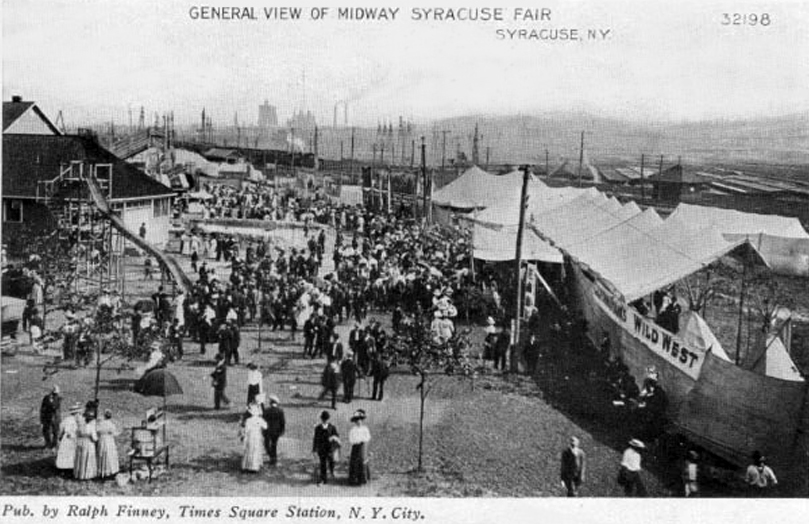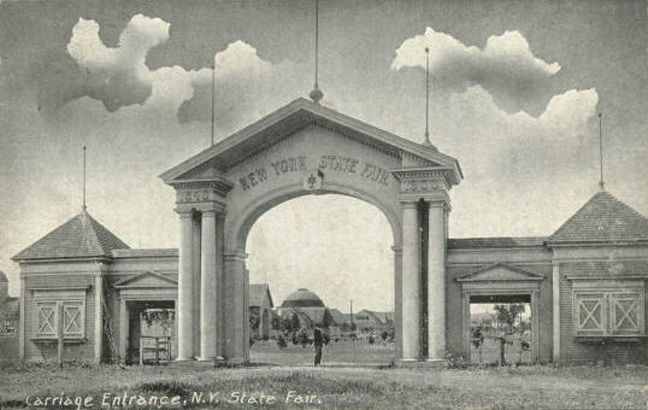NY State Fair part 1 - Watching young people and their animals
For
twelve days every year, ending on Labor Day Weekend, Syracuse N.Y. hosts The
Great New York State Fair. Some state fairs might get more publicity (I’m
looking at you, Iowa and Texas) but the New York State Fair can hold its head
up high as a great celebration of farm and fun.
The
first New York State Fair took place in 1841 in Syracuse NY. It was sponsored
by the NY Agricultural Society. For the next 58 years the fair moved around the
state from year to year. In 1889 the Syracuse Land Company donated 100 acres of
land to the Agricultural Society for the building of a permanent fair grounds.
Today the fairgrounds occupy 375 acres and include animal barns and show rings,
exhibition buildings and a midway with about 70 rides.
 |
| NY State Fair Midway - 1910 - https://upload.wikimedia.org/wikipedia/commons/1/1a/Nystate-fair_1910_midway.jpg |
I
had not been to the fair since I was 10 years old, so my chance to visit this
year was something I was excited about. I am a city kid. I don’t do animals.
But I have to say that I was entranced by watching people from age 7 to 70
handling animals and showing their skills. For three days I
 |
| Julie preparing a goat to be shown |
4H and FFA
Two
of the groups that work with young people, training them to be farmers and to
learn about the business of farming are the 4-H Club and Future Farmers of
America (FFA).
| http://assets.slate.wvu.edu/resources/593/1329250798.gif |
The
4-H Club
has
been in existence for over 100 years. The four ‘H’s are Heart, Head, Hand
and Health. Today it is run in conjunction with the U.S. Department of
Agriculture and over 100 land grant universities around the country. To quote
their web-site:
“Today, 4-H serves youth in rural, urban, and
suburban communities in every state across the nation. 4-H’ers are tackling the
nation’s top issues, from global
food security, climate change and sustainable energy to childhood obesity and
food safety. 4-H out-of-school programming, in-school enrichment
programs, clubs and camps also offer a wide variety of STEM opportunities –
from agricultural and animal
sciences to rocketry, robotics, environmental protection and computer science –
to improve the nation’s ability to compete in key scientific fields and take on
the leading challenges of the 21st century.”
| http://assets.slate.wvu.edu/resources/593/1329250798.gif |
The
Future Farmers of America (FFA) was formed in 1928 in an attempt to deal with
the problem of many young people choosing to leave the farm for the city. In
1935 the New Farmers of America formed as a brother organization for
African-American youth. These two groups
merged in 1965. Today over 600,000 young people participate in over 7,000 FFA
chapters. To quote their web-site:
“Today, the National FFA Organization remains
committed to the individual student, providing a path to achievement in premier
leadership, personal growth and career success through
agricultural education.”
At
the New York State Fair these groups play a key role in developing youth
talent. They ran sessions in which young people were trained on how to judge
the showing of animals. I walked in to the goat tent on my first morning and
witnessed a group of about 50 teenagers being shown 4 goats. They
filled out comment sheets that would later be evaluated and
graded.
 |
| Teens judging goats |
I
watched three groups of young people, age 7-14, show pigs. Now at first, pig
showing looks like
the sidewalk in Times Square. A
group of seven or eight young men and women enter a 30 x 30 foot show ring with
their pigs. Then for the next 10 minutes or so they guide their pigs back and
forth around the ring, all the while trying to keep eye contact with the judge
and a smile on their face. Since the pigs try to go where they want, and young
people are watching their pig and the judge, there were often traffic jams of
pigs and showmen/women. But judges were great. They moved around to get the
best view of all of the animals and of their handlers, and made sense of the
chaos. He was able to pick out the best handler in all three groups.
 |
| Pig Showing |
 |
| Judging the pigs |
By
comparison, watching young people show cattle beef was a calm a stately affair.
The participants enter into a show ring that is about 30 feet by 100 feet. They
parade the cattle around in a line and then line up in an orderly fashion. The
judge watches them and studies the cattle. He calls them out one by one for a
better look, and then places them in their finishing order. Meanwhile these
teenagers have to get the cows to do what they want them to do. To hold their
head up, the stand with their feet placed correctly for the judge, and to move
when and where they need to go.
I
really did enjoy watching these young men and women perform. It was obvious
that they had put a lot of time in preparing for the fair. In fact while I was
watching the pig showing, I overheard a conversation between a mother and a
daughter who couldn’t have been but 4 years old. The child had been asked if
she wanted to show a hog. It was obvious from the conversation that this was
not the first time that she shown a hog. 4 years old! People say that small
farms are dying out, and I don’t know enough about it to comment on that. But
the young people I saw were definitely passionate about what they were doing,
and they certainly
expressed
determination to continue farming when they grew up. While it is not the life
that I would have wanted to live, I certain respect these families and young
people for their commitment.













I have never been a fan of State Fairs. Being a Bronx girl whose parents walked away from their roots in rural farming community, agricultural fairs held no interest for me. However, you offer a different point of view. While I chose city life over the farm, I have great respect for young people who make other choices. You helped me go beyond my own prejudices and appreciate a different way of life.
ReplyDelete